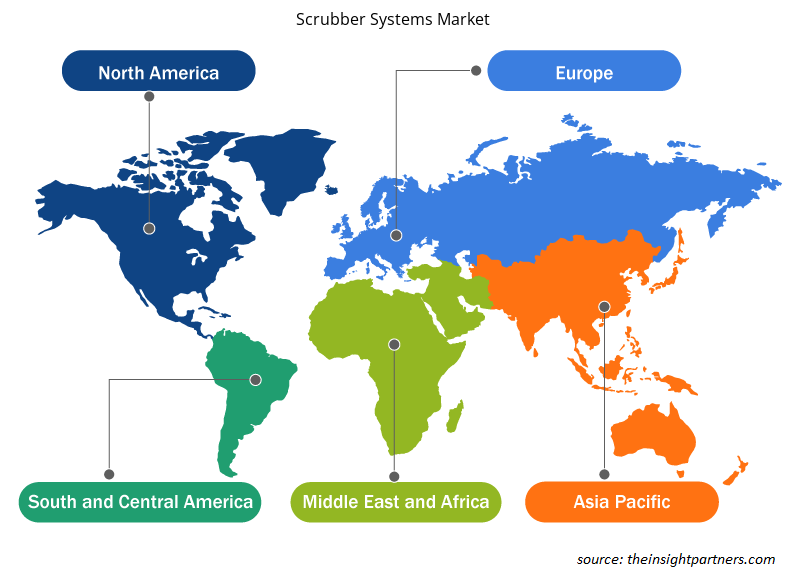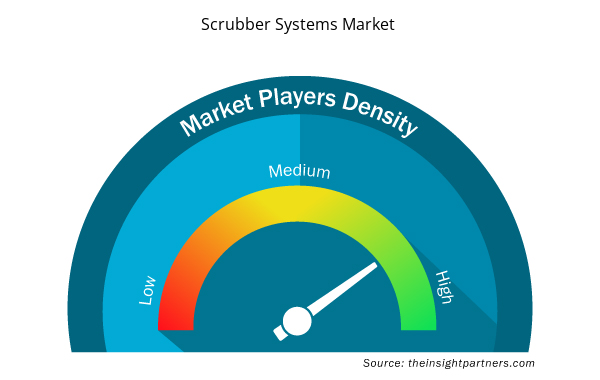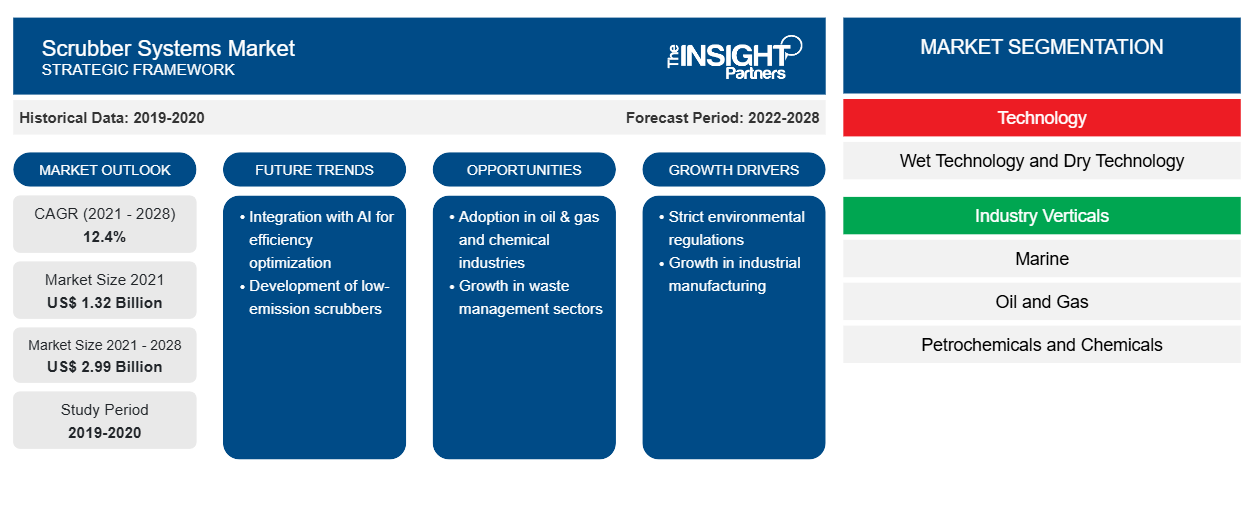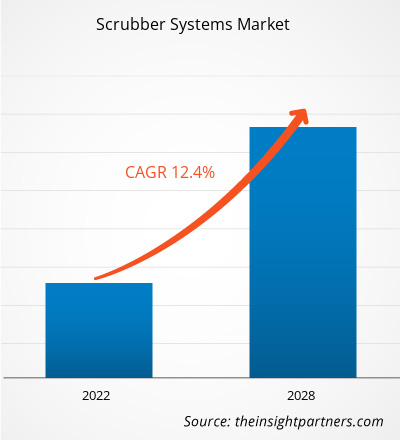Nel 2021 il mercato dei sistemi di depurazione è stato valutato 1.316,0 milioni di dollari USA e si prevede che raggiungerà i 2.989,2 milioni di dollari USA entro il 2028; si prevede una crescita a un CAGR del 12,4% dal 2021 al 2028.
Le principali industrie manifatturiere come cemento, vetro, prodotti chimici e petrolchimici, alimenti e agricoltura e prodotti farmaceutici sono note per le emissioni di gas nocivi. Quindi, le severe normative ambientali imposte a queste industrie stanno guidando il mercato. Ad esempio, l'industria del cemento è una delle principali industrie inquinanti in quanto rilascia particolato di biossido di azoto (NO2) e diossido di zolfo (SO2) durante la produzione. Inoltre, l'aumento del commercio internazionale attraverso le rotte marittime e l'aumento delle attività ricreative stanno spingendo la crescita del mercato dei sistemi di depurazione . L'aumento del commercio marittimo globale può essere attribuito al suo costo di trasporto economico e alla domanda globale in continua crescita di beni e prodotti petroliferi. Inoltre, la crescente partecipazione ad attività ricreative come crociere e viaggi internazionali sta aumentando l'uso di navi marittime e di conseguenza alimentando la crescita del mercato dei sistemi di depurazione.
Impatto della pandemia di COVID-19 sul mercato dei sistemi di depurazione
L'improvviso scoppio del COVID-19 ha visto un impatto negativo significativo del COVID-19 sulla domanda per il settore dei sistemi di depurazione sulla scia della pandemia globale. Ad agosto 2020, Yara Marine Technologies, uno dei principali attori degli scrubber marini, ha distolto la sua attenzione dal mercato a causa del COVID-19 e dei bassi prezzi del petrolio. Il responsabile dell'innovazione dell'azienda ha dichiarato che avevano grandi speranze nel 2020 per i sistemi di depurazione, ma il COVID-19 ha cambiato tutto. Tuttavia, il mercato ha assistito a un aumento della domanda dal terzo trimestre poiché diversi governi hanno introdotto severe normative per mantenere l'aria pulita. I sistemi di depurazione dell'aria svolgono un ruolo fondamentale nella rimozione di particelle pericolose dai gas di scarico, aiutando il mercato a riprendere slancio.
Personalizza questo report in base alle tue esigenze
Riceverai la personalizzazione gratuita di qualsiasi report, comprese parti di questo report, o analisi a livello nazionale, pacchetto dati Excel, oltre a usufruire di grandi offerte e sconti per start-up e università
- Scopri le principali tendenze di mercato in questo rapporto.Questo campione GRATUITO includerà analisi di dati che spaziano dalle tendenze di mercato alle stime e alle previsioni.
Approfondimenti di mercato –
Mercato dei sistemi di depurazione
Aumento del commercio marittimo globale e delle attività ricreative
L'aumento degli scambi commerciali internazionali attraverso le rotte marittime e l'aumento delle attività ricreative stanno spingendo la crescita del mercato dei sistemi di depurazione. L'aumento del commercio marittimo globale può essere attribuito al suo costo di trasporto economico e alla domanda globale in continua crescita di beni e prodotti petroliferi. Inoltre, la crescente partecipazione ad attività ricreative come le crociere e i viaggi internazionali sta aumentando l'uso di navi marittime e di conseguenza alimentando la crescita del mercato dei sistemi di depurazione. L'aumento delle attività ricreative può essere attribuito all'aumento del reddito pro capite dei consumatori. Quindi, l'aumento delle emissioni di zolfo dalle navi, dovuto al fiorente commercio globale, e l'intensificazione del trasporto marittimo nelle economie in via di sviluppo e sviluppate stanno incrementando le installazioni dei sistemi di depurazione.
Approfondimenti basati sulla tecnologia
In base alla tecnologia, il mercato dei sistemi scrubber è segmentato in tecnologia a umido e tecnologia a secco. Il segmento della tecnologia a umido ha detenuto una quota di mercato maggiore nel 2021.
Gli operatori che operano nel mercato dei sistemi di depurazione si concentrano principalmente sullo sviluppo di prodotti avanzati ed efficienti.
- Nel luglio 2021, Babcock & Wilcox Environmental ha annunciato che avrebbe sostenuto la richiesta dell'Amager Resource Center di costruire un impianto avanzato di cattura dell'anidride carbonica presso l'impianto di termovalorizzazione dei rifiuti di Amager-Bakke (Copenhill) di ARC a Copenaghen, in Danimarca, per oltre 140 milioni di dollari.
- A settembre 2021, DuPont Clean Technologies ha introdotto una soluzione innovativa e avanzata per la soppressione del pennacchio di vapore per i suoi scrubber MECS DynaWave nelle applicazioni delle unità di recupero dello zolfo (SRU). Sennuba fornisce un controllo affidabile della corrosione e la soppressione del pennacchio nel sistema di scrubbing con un rischio minimo di intasamento.
Approfondimenti regionali sul mercato dei sistemi di depurazione
Le tendenze regionali e i fattori che influenzano il mercato dei sistemi di lavaggio durante il periodo di previsione sono stati ampiamente spiegati dagli analisti di Insight Partners. Questa sezione discute anche i segmenti e la geografia del mercato dei sistemi di lavaggio in Nord America, Europa, Asia Pacifico, Medio Oriente e Africa e America meridionale e centrale.

- Ottieni i dati specifici regionali per il mercato dei sistemi di depurazione
Ambito del rapporto di mercato sui sistemi di depurazione
| Attributo del report | Dettagli |
|---|---|
| Dimensioni del mercato nel 2021 | 1,32 miliardi di dollari USA |
| Dimensioni del mercato entro il 2028 | 2,99 miliardi di dollari USA |
| CAGR globale (2021 - 2028) | 12,4% |
| Dati storici | 2019-2020 |
| Periodo di previsione | 2022-2028 |
| Segmenti coperti | Per tecnologia
|
| Regioni e Paesi coperti | America del Nord
|
| Leader di mercato e profili aziendali chiave |
|
Densità dei player del mercato dei sistemi di depurazione: comprendere il suo impatto sulle dinamiche aziendali
Il mercato dei sistemi di lavaggio sta crescendo rapidamente, spinto dalla crescente domanda degli utenti finali dovuta a fattori quali l'evoluzione delle preferenze dei consumatori, i progressi tecnologici e una maggiore consapevolezza dei vantaggi del prodotto. Con l'aumento della domanda, le aziende stanno ampliando le loro offerte, innovando per soddisfare le esigenze dei consumatori e capitalizzando sulle tendenze emergenti, il che alimenta ulteriormente la crescita del mercato.
La densità degli operatori di mercato si riferisce alla distribuzione di aziende o società che operano in un particolare mercato o settore. Indica quanti concorrenti (operatori di mercato) sono presenti in un dato spazio di mercato in relazione alle sue dimensioni o al valore di mercato totale.
Le principali aziende che operano nel mercato dei sistemi di depurazione sono:
- Babcock & Wilcox Enterprises, Inc
- Alfa Lavall
- DuPont de Nemours, Inc.
- FUJI ELECTRIC CO., LTD.
- Gruppo GEA AG
Disclaimer : le aziende elencate sopra non sono classificate secondo un ordine particolare.

- Ottieni una panoramica dei principali attori del mercato dei sistemi di depurazione
Il mercato dei sistemi di depurazione è stato segmentato come segue:
Mercato dei sistemi di depurazione – per tecnologia
Mercato dei sistemi di depurazione – per settori verticali industriali
- Marino
- Petrolio e gas
- Petrolchimica e prodotti chimici
- Cibo e agricoltura
- Trattamento delle acque reflue
- Assistenza sanitaria
- Altri
Mercato del sistema di depurazione – per area geografica
- America del Nord
- NOI
- Canada
- Messico
- Europa
- Germania
- Francia
- Italia
- Regno Unito
- Russia
- Resto d'Europa
- Asia Pacifico (APAC)
- Cina
- India
- Giappone
- Corea del Sud
- Thailandia
- Resto dell'APAC
- Medio Oriente e Africa
- Sudafrica
- Resto del MEA
- Sud America
- Brasile
- Argentina
- Resto del SAM
Mercato dei sistemi di depurazione – Profili aziendali
- Babcock & Wilcox Enterprises, Inc
- Alfa Lavall
- DuPont de Nemours, Inc.
- FUJI ELECTRIC CO., LTD.
- Gruppo GEA AG
- Società Wärtsilä
- prosciutto
- Tecnologie marine Yara
- Gruppo di soluzioni ambientali Verantis
- CECO Ambientale
- Analisi storica (2 anni), anno base, previsione (7 anni) con CAGR
- Analisi PEST e SWOT
- Valore/volume delle dimensioni del mercato - Globale, regionale, nazionale
- Industria e panorama competitivo
- Set di dati Excel



Report Coverage
Revenue forecast, Company Analysis, Industry landscape, Growth factors, and Trends

Segment Covered
This text is related
to segments covered.

Regional Scope
North America, Europe, Asia Pacific, Middle East & Africa, South & Central America

Country Scope
This text is related
to country scope.
Domande frequenti
The scrubber system market in Europe is sub-segmented into France, Germany, Russia, Italy, the UK, and the Rest of Europe. Compared with the Nordic and Eastern European countries, western European countries are more developed and technologically advanced. EU is increasingly stringent policies to observe the numerous constituents of air which is anticipated to propel the growth of the scrubber system market. Also, despite the EU proposals, all member states of the IMO again approved scrubbing system technology as an accepted compliance method. According to European exports, Germany is one of the essential countries for deploying marine scrubbers in long voyage vessels.
The rising application of sulfur dioxide (SOx) removal scrubber technology in the marine industry has gained significant traction in recent years. It is expected to propel the growth of the scrubber system market in the coming years. The SOx removal scrubber technology offers three different scrubber technology variants based on the vessel's operating profile, such as open-loop scrubber technology, closed-loop scrubber technology, and hybrid scrubber technology. The open-loop scrubber technology uses seawater to scrub the exhaust gas. It discharges the sulfuric acid content water back into the sea as the natural alkalinity of seawater neutralizes the acid.
Marine segment of the scrubber system market comprises ship industries including passenger and cargo. Marine segment holds the largest revenue of the scrubber system market and anticipated to maintain its dominance in the coming years. The growth of the segment can be attributed to the rising stringent policies for the ship industry. For instance, In January 2020, International Maritime Organization (IMO) has changed the emission rules and limits the sulphur in the fuel oil used on board ships operating outside designated emission control areas to 0.5% m/m (mass by mass) previously the limit was 3.5%. Similarly, within specific designated emission control areas the limits are 0.1% m/m.
The wet technology segment of the scrubber system market is poised to grow with significant during the estimated period. The growth of the segment can be attributed to its large application in a wide range of industries such as oil and gas, petrochemicals, marine, wastewater treatment, electronics and semiconductor, and others. For instance, CECO Environmental Corp. is providing CECO HEE-Duall Scrubber (a wet scrubber system) to leading global semiconductor chip manufacturers for removing harmful gaseous contaminants. The technology facilitates an efficient air pollution control methods for eliminating particles as well as gases from industrial exhaust streams. The Wet scrubber technology are considered the most appropriate device for air pollution control which collects both gas and particulates in a single system.
Major manufacturing industries such as cement, glass, chemical and petrochemical, food and agriculture, and pharmaceuticals are known for harmful gas emissions. Hence, the stringent environmental regulations on these industries are driving the market. For instance, the cement industry is one of the major polluting industries as it releases nitrogen dioxide (NO2) and sulfur dioxide (SO2) particulate during production.
The rapid industrialization in developing economies is creating a lucrative opportunity for scrubber system manufacturers to augment their market share further. The growing industrial activities in developing economies such as China, India, Brazil, and Vietnam result in more establishments of plants and factories of various industries. In this rapid industrialization era, the developing economies are witnessing a surge in new production facilities or capacities of the manufacturing industries such as cement, glass, petrochemicals and chemicals, oil & gas, food & beverages, pharmaceuticals, mining & metallurgy, and pulp & paper. For instance, China's National Bureau of Statistics (NBS) has reported a 1.6% year-on-year rise in cement production to 2.377 billion tons for 2020. Also, the country is witnessing constructions of 3,203 cement factory projects, which started in December 2020, with a total investment of US$ 415.6 billion.
Trends and growth analysis reports related to Electronics and Semiconductor : READ MORE..
The List of Companies - Scrubber System Market
- Babcock & Wilcox Enterprises, Inc
- Alfa Laval
- DuPont de Nemours, Inc.
- FUJI ELECTRIC CO., LTD.
- GEA Group AG
- Wärtsilä Corporation
- Hamon
- Yara Marine Technologies
- Verantis Environmental Solutions Group
- CECO Environmental
The Insight Partners performs research in 4 major stages: Data Collection & Secondary Research, Primary Research, Data Analysis and Data Triangulation & Final Review.
- Data Collection and Secondary Research:
As a market research and consulting firm operating from a decade, we have published and advised several client across the globe. First step for any study will start with an assessment of currently available data and insights from existing reports. Further, historical and current market information is collected from Investor Presentations, Annual Reports, SEC Filings, etc., and other information related to company’s performance and market positioning are gathered from Paid Databases (Factiva, Hoovers, and Reuters) and various other publications available in public domain.
Several associations trade associates, technical forums, institutes, societies and organization are accessed to gain technical as well as market related insights through their publications such as research papers, blogs and press releases related to the studies are referred to get cues about the market. Further, white papers, journals, magazines, and other news articles published in last 3 years are scrutinized and analyzed to understand the current market trends.
- Primary Research:
The primarily interview analysis comprise of data obtained from industry participants interview and answers to survey questions gathered by in-house primary team.
For primary research, interviews are conducted with industry experts/CEOs/Marketing Managers/VPs/Subject Matter Experts from both demand and supply side to get a 360-degree view of the market. The primary team conducts several interviews based on the complexity of the markets to understand the various market trends and dynamics which makes research more credible and precise.
A typical research interview fulfils the following functions:
- Provides first-hand information on the market size, market trends, growth trends, competitive landscape, and outlook
- Validates and strengthens in-house secondary research findings
- Develops the analysis team’s expertise and market understanding
Primary research involves email interactions and telephone interviews for each market, category, segment, and sub-segment across geographies. The participants who typically take part in such a process include, but are not limited to:
- Industry participants: VPs, business development managers, market intelligence managers and national sales managers
- Outside experts: Valuation experts, research analysts and key opinion leaders specializing in the electronics and semiconductor industry.
Below is the breakup of our primary respondents by company, designation, and region:

Once we receive the confirmation from primary research sources or primary respondents, we finalize the base year market estimation and forecast the data as per the macroeconomic and microeconomic factors assessed during data collection.
- Data Analysis:
Once data is validated through both secondary as well as primary respondents, we finalize the market estimations by hypothesis formulation and factor analysis at regional and country level.
- Macro-Economic Factor Analysis:
We analyse macroeconomic indicators such the gross domestic product (GDP), increase in the demand for goods and services across industries, technological advancement, regional economic growth, governmental policies, the influence of COVID-19, PEST analysis, and other aspects. This analysis aids in setting benchmarks for various nations/regions and approximating market splits. Additionally, the general trend of the aforementioned components aid in determining the market's development possibilities.
- Country Level Data:
Various factors that are especially aligned to the country are taken into account to determine the market size for a certain area and country, including the presence of vendors, such as headquarters and offices, the country's GDP, demand patterns, and industry growth. To comprehend the market dynamics for the nation, a number of growth variables, inhibitors, application areas, and current market trends are researched. The aforementioned elements aid in determining the country's overall market's growth potential.
- Company Profile:
The “Table of Contents” is formulated by listing and analyzing more than 25 - 30 companies operating in the market ecosystem across geographies. However, we profile only 10 companies as a standard practice in our syndicate reports. These 10 companies comprise leading, emerging, and regional players. Nonetheless, our analysis is not restricted to the 10 listed companies, we also analyze other companies present in the market to develop a holistic view and understand the prevailing trends. The “Company Profiles” section in the report covers key facts, business description, products & services, financial information, SWOT analysis, and key developments. The financial information presented is extracted from the annual reports and official documents of the publicly listed companies. Upon collecting the information for the sections of respective companies, we verify them via various primary sources and then compile the data in respective company profiles. The company level information helps us in deriving the base number as well as in forecasting the market size.
- Developing Base Number:
Aggregation of sales statistics (2020-2022) and macro-economic factor, and other secondary and primary research insights are utilized to arrive at base number and related market shares for 2022. The data gaps are identified in this step and relevant market data is analyzed, collected from paid primary interviews or databases. On finalizing the base year market size, forecasts are developed on the basis of macro-economic, industry and market growth factors and company level analysis.
- Data Triangulation and Final Review:
The market findings and base year market size calculations are validated from supply as well as demand side. Demand side validations are based on macro-economic factor analysis and benchmarks for respective regions and countries. In case of supply side validations, revenues of major companies are estimated (in case not available) based on industry benchmark, approximate number of employees, product portfolio, and primary interviews revenues are gathered. Further revenue from target product/service segment is assessed to avoid overshooting of market statistics. In case of heavy deviations between supply and demand side values, all thes steps are repeated to achieve synchronization.
We follow an iterative model, wherein we share our research findings with Subject Matter Experts (SME’s) and Key Opinion Leaders (KOLs) until consensus view of the market is not formulated – this model negates any drastic deviation in the opinions of experts. Only validated and universally acceptable research findings are quoted in our reports.
We have important check points that we use to validate our research findings – which we call – data triangulation, where we validate the information, we generate from secondary sources with primary interviews and then we re-validate with our internal data bases and Subject matter experts. This comprehensive model enables us to deliver high quality, reliable data in shortest possible time.


 Ottieni un campione gratuito per questo repot
Ottieni un campione gratuito per questo repot